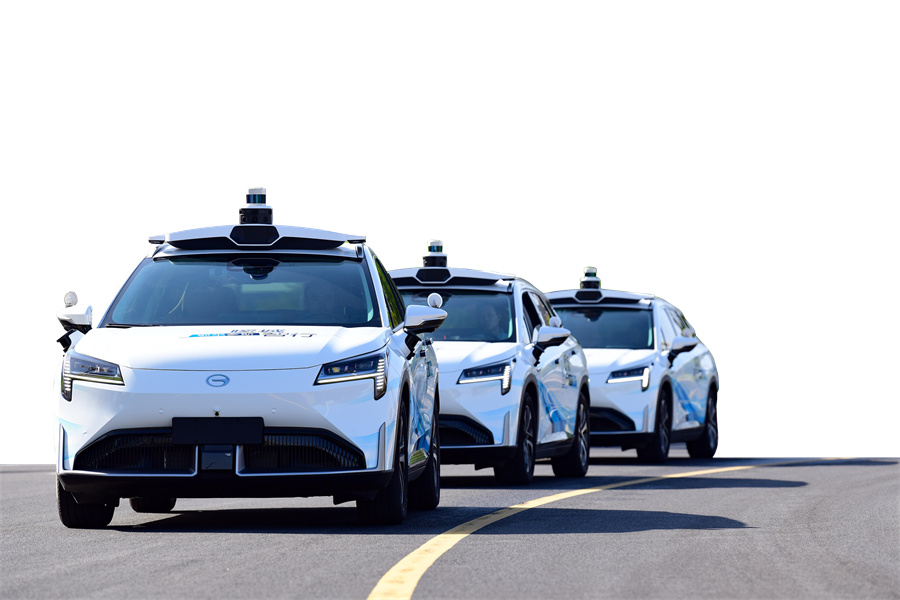Robotaxis — arriving at a future near you
Autonomous vehicles grow in popularity despite concerns over safety, reliability


Congestion concern
Baidu insists that robotaxis, if applied at a city-level, can solve problems such as traffic jams and road accidents.
However, as long as there are drivers and robotaxis on the road at the same time, reduced congestion and collision-free motoring will not happen, analysts said.
Robotaxis tend to be good at following traffic rules and staying alert, but human drivers sometimes cut lanes and don't always focus on road conditions, they added.
Zhang Xiang, an auto analyst at North China University of Technology, said it will take at least 10 years for large-scale business operations of robotaxis to come to fruition.
Besides technological glitches that need to be improved, robotaxis now in operation attract customers who are not in a hurry and who want to have a novel experience.
Unlike regular taxis, they pick up and drop off passengers at fixed stops. They also have more conservative rules about road safety, and operate slower than regular taxis.
Robotaxis may suit customers who want to be left alone. But they may not be attractive to out-of-town visitors who want recommendations about a city from the driver. However, they remove the potential of a driver taking an unnecessary detour to charge more.
Business sense
Despite the teething problems, robotaxis will soon make sense commercially. Baidu said with decreasing hardware costs and increasing orders, Apollo Go is expected to become profitable by 2025.
Apollo Go loses almost $11,000 a car annually in Wuhan, Haitong International Securities estimated. A lower-cost driverless model could enable per-vehicle annual profit of nearly $16,000, the securities firm said.
Chen Zhuo, Apollo Go's general manager, said the firm would become "the world's first commercially profitable" autonomous-driving platform.
Pony.ai is confident about the sector's prospects as well. In a 160 square-km designated zone in Beijing's E-Town, a national-level economic-technological development area, the company operates nearly 100 robotaxis.
Compared to years ago, the rides are much smoother with no abrupt braking, and the vehicles run in a similar way to other taxi services.
Pony.ai aims to increase its single-city robotaxi fleet tenfold by 2025 or 2026, said the company's vice-president, Zhang, in an interview with Xinhua.
"We've now come to the stage where it is possible to reduce costs on a larger scale of commercialization," he said. "As long as the robotaxi fleet reaches above 1,000 in one city, we will be able to break even in operation (terms)."
Pony.ai is teaming up with Japanese carmaker Toyota to roll out new-generation vehicles. They will have pre-installed autonomous driving technology, making production more efficient.
"Five or six years ago, most people doubted whether autonomous driving could take root in China. There are no such doubts now," Zhang said.
Attracting financing
Investor interest is also fueling the sector's progress.
Pony.ai has secured more than $1.4 billion of financing from both domestic and foreign investors since 2017. The company was valued at $8.5 billion as of October last year.
The investment environment for the industry has been improving since last year, despite fluctuations in previous years, according to the company.
WeRide, based in Guangzhou, Guangdong province, plans to offer 6.45 million American depositary shares at a price range of $15.50 to $18.50 in its upcoming initial public offering, according to a company filing with the US Securities and Exchange Commission in August.
The company reported revenue of 401.8 million yuan in 2023. For the first six months of this year, its revenue was 150.3 million yuan, according to the filing.
WeRide generates most of its revenue from sales of its Level 4 autonomous driving vehicles, "primarily including robobuses, robotaxis and robosweepers, and related sensor suites; and … the provision of L4 autonomous driving and advanced driver-assistance system services, including the provision of L4 operational and technical support services as well as ADAS research and development services", the filing said.
The Society of Automotive Engineers International defines six levels of automation from Level 0 to Level 5. Level 4 means the vehicle can operate itself in most circumstances, while L5, also known as full driving automation, requires no human participation.
All China's robotaxi companies are working on Level 4 vehicles.
World-leading growth
Global consulting firm McKinsey& Company has forecast that China will become the world's largest market for self-driving vehicles, with revenue from such vehicles and mobility services exceeding $500 billion by 2030.
"We've seen an acceleration in China. There's certainly now a rapid pace of permits being issued," said Boston Consulting Group managing director Augustin Wegscheider. "The US has been a lot more gradual."
Alphabet's Waymo is the only United States firm operating unmanned robotaxis that collect fares.
The company has about 700 cars operating in San Francisco and Los Angeles in California, Phoenix in Arizona, and Austin, Texas, but not all of them are in service at all times.
Cruise, backed by General Motors, restarted testing in April after one of its vehicles hit a pedestrian last year. Cruise said it operates in three cities, with safety its core mission.
"There's a clear contrast between US and China" with robotaxi developers facing far more scrutiny and higher hurdles in the US, former Waymo CEO John Krafcik said in an interview with Reuters.
China will operate the world's largest robotaxi fleet of about 12 million self-driving vehicles by 2040, followed by the US with around 7 million, according to a report by research company BloombergNEF.
Li Hengyu, vice-president of Pony.ai and head of its robotruck business unit, said: "The central and local governments in China rank first in the world in terms of their openness and understanding of autonomous driving."
China has also been stepping up efforts to integrate vehicles, roads, and cloud computing, which is a crucial step to grow smart vehicles into smart cities.
In July, five ministries, including the Ministry of Industry and Information Technology and the Ministry of Transport, issued a notice to identify 20 cities or city clusters, including Beijing, Shanghai and Guangzhou, as pilot areas for the technology.
























